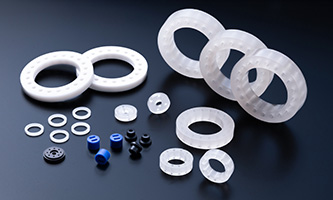ケーススタディcase study
長窯はこれからも、高度な技術と柔軟な対応力で、お客様の課題解決に取り組んでいきます
お気軽にご相談ください
- すべて
- ガラス焼結体
- ハーメチックシール
-
ガラス焼結体
最終目標はもっと薄く
お客様のご要望
高さが0.2mm以下の製品を製作できないかと要望がありました。

-
課題
成形工程では成形体が薄く欠けやすいため、焼結治具への搬送方法の見直し、焼結工程では製品の歪みを防ぐための最適な製造条件を模索する必要がありました。
-
解決策
粉末顆粒の生産時の条件を変更することで、成形体が変形しにくくなり、結果、成形体の移動も安定しました。
また、成形後、焼結治具へ移し替える際の治具や整列方法を改善させ、薄く欠けやすい製品もスムーズに扱えるようになりました。焼結工程では焼結方法や焼結治具を変更し製品の歪みを最小限に抑えることに成功しました。
-
-
ガラス焼結体
ノーベル賞のお手伝いができた製品よりも
更に大型製品!お客様のご要望
今まで使用実績のない、お客様御指定の粉末材料を使っての大型の光電子増倍管用ガラスを製作してほしいとのご依頼がありました。

-
課題
現有設備(成形機)では保有している金型の取付けができず、成形時の圧力も不足するため成形できませんでした。
そこで、どちらの問題も解決する、新型の成形機が必要になりました。 -
解決策
中小企業庁の「ものづくり補助金」を利用して当社で最も大きい20tプレス導入し、顧客の要望する製品を製造し、使っていただくことができました。これにより現在外径φ85mm位のものまで生産可能となりました。
-
-
ガラス焼結体
効率化と品質向上を同時に実現!
ガラス1個使いの挑戦お客様のご要望
「2個のガラスを使用したハーメチックシール工程において、組み付け時の作業ミスやガラスの間に、気泡によるリークが品質上課題となっているため、2個分の高さのあるガラスを製作できないか?」とご相談をいただきました。

-
課題
高さのある製品を製作する際には、次の2つの大きな課題がありました。
①成形工程では、金型への粉末ガラスの充填量を安定させること
②焼結工程では、製品の歪みや変色を防ぐための最適な製造条件を模索すること -
解決策
①の課題に対しては、粉末の充填量を安定させるために、粉末顆粒の粒度変更や金型設計の見直し、さらには粉末成形機の粉末供給方法を改良した結果、充填量の向上と安定化を実現しました。
②の課題に対しては、ボートへの製品整列方法の改善に取り組み、製品の歪みや変色を最小限に抑えることに成功しました。 これらの改良を重ねた結果、ご要望に沿った高さのガラス製品を実現し、お客様の品質改善に貢献することができました。
このノウハウを活かし、金型の外内径差の10倍までの高さの製品であれば安定した生産が可能です。(例:外内径差が0.15mmの場合、高さ1.5mmが目安となります)
-
-
ハーメチックシール
鉛フリーの低融点ガラスを使った
ハーメチックシールでセンサ開発に貢献お客様のご要望
「センサーの封止部分に鉛を使わずに製作したい」
環境規制の厳格化や安全性の観点から、鉛を使用しない低融点ガラスを使ったハーメチックシールが求められていました。
-
課題
お客様は樹脂による封止を試みましたが、期待した性能を得ることができず、ガラス封止の方法を模索している中でご連絡をいただきました。しかし、今回の封止は金属やセラミックといった複合素材との組み合わせが必要であり、慎重なアプローチが求められました。
-
解決策
封止条件を最適化するため、時間・環境・温度・圧力などを変えながら50回以上のテストを実施。試行錯誤を重ねた結果、お客様の要望を満たすことに成功しました。お客様にも大変喜んでいただき、製品化にも貢献することができました。
-



